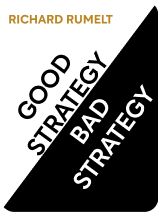

This article is an excerpt from the Shortform book guide to "Good Strategy Bad Strategy" by Richard Rumelt. Shortform has the world's best summaries and analyses of books you should be reading.
Like this article? Sign up for a free trial here .
What’s the main strategic goals of your organization? Are you clear about the direction in which you want to develop your company?
According to Richard Rumelt, the author of Good Strategy, Bad Strategy, when it comes to setting big-picture strategic goals of an organization—no matter how large—it’s best to choose one or two narrow goals and abandon other goals that will only serve to spread your resources and focus. Further, don’t mistake growth as a goal: growth is a sign of a healthy company but it’s not a strategic goal in and of itself. Then, choose feasible objectives that you can reasonably expect to achieve in pursuit of your goal.
Keep reading to find out how to craft strategic goals for your organization, according to strategist Richard Rumelt.
Organizational Strategy
At its heart, a good organizational strategy is all about focus: A leader must identify one or two strategic goals of an organization and then come up with a plan to direct actions and resources at these goals, to the exclusion of other, less-critical goals that might distract from this focus. By limiting her strategy’s focus, she increases the likelihood of reaching those goals, rather than trying to take on too much.
Strategic focus works in two directions: internally and externally. To focus your efforts internally, get rid of policies and aims that don’t support your primary goal. To focus your efforts externally, direct them at a specific, defined target. Often, a company will accomplish this by narrowing its target market down to a smaller segment or passing up opportunities to provide additional services if those services dilute its focus. It can be difficult to resist chasing all pieces of the pie, but your company will very often be stronger if it does so.
Case Study: Crown Cork & Seal (Part 1 of 2)
Crown Cork & Seal provides an excellent example of how a tight focus on a smaller market segment and a specific service can drive a company’s success.
Crown is a maker of metal containers. In its early years in the 1960s, the company had three primary competitors, each of which manufactured cans for beverage companies and dominated the market with large, long production runs for these companies. Instead of chasing this business, though, Crown focused on a niche market of shorter rush orders for smaller companies—seasonal orders or unexpected surges in demand.
Even though Crown was much smaller than its rivals, it was far more profitable than them. Because it was not caught in long-term contracts with the dominant players, the company remained in control of the bargaining process and was better positioned to set its prices. Further, it could charge a premium for its services, offering expertise and customer relations that its larger rivals couldn’t match. By focusing on this smaller market, Crown was thus able to avoid many of the competitive pressures that drove down profits for its competitors.
Don’t Chase Growth
A good strategy recognizes the difference between organic, healthy growth and manufactured, unhealthy growth, and resists the temptation to grow just for the sake of growing. Healthy growth comes from a combination of growing demand and expanded capabilities. Unhealthy growth is forced through acquisitions that may not fit a company’s original strategic vision. Often, conglomerates formed this way are loosely integrated, are unfocused, and end in failure.
Leaders often look to growth as a means of increasing efficiency and lowering costs. They also hope being larger will open their company up to more opportunities. Unfortunately, both of these beliefs often turn out to be wrong.
First, the hope for greater efficiency and lower costs frequently turns out to be a myth for a number of reasons. Executives of large firms typically earn higher salaries, and even though some executives are let go after acquisitions, a significant number of them are kept on and simply moved into more peripheral roles, thus retaining their overhead. Further, there are high costs associated with buying a company: Companies, especially public ones, are typically overpriced, and you may end up paying twenty-five percent more than the company’s market value. There are also hefty fees paid to the bankers, consultants, and lawyers who make the merger happen.
Second, a company caught up in growth-by-acquisition and hoping for new opportunities often finds that the “growth” they’ve added to their portfolios is really no more than substitution of one new market segment for an older market segment they’d already conquered. For example, image an established metals company has recently acquired a plastics company. The metals company’s customers might start buying plastic goods instead of metal goods, but won’t buy both, so overall sales might remain flat. Growth based on substitution has inherent limitations and eventually, such growth will slow or even halt.
Case Study: Crown Cork & Seal (Part 2 of 2)
The story of Crown Cork & Seal in the 1990s illustrates the dangers of acquiring companies and losing sight of core strategic insights. In 1989, the CEO who had spearheaded Crown’s focused strategy (discussed above) stepped down. The new CEO immediately embarked on an acquisitions spree. He bought one of his American competitors, several other metals companies, a plastics company, and the largest plastics and metal manufacturer in Europe. His stated strategy was to get bigger in order to build a platform for further growth—in other words, to grow in order to grow.
However, the company ended up simply substituting one product category—metals—for another—plastics. It began producing plastic containers for its clients rather than metal ones, but its overall business didn’t increase. The company lost sight of the competitive advantage that had powered its success up to that point: flexibility, personalized customer service, short runs, and a strong bargaining position against its customers. Crown’s shareholder returns and stock value plummeted.
Choose Feasible Objectives
A good strategy will focus on achievable, realistic objectives that enable it to reach its larger, more overarching goals.
If goals are the ultimate driving force behind a strategy, objectives are the smaller, sub-goals that plot out the path to achieving them. When choosing objectives, it is crucial that leaders pick ones that are ambitious but reasonable given an organization’s resources.
An even better approach is to choose objectives that seem out of reach but are actually perfectly realistic based on your organization’s capabilities. These kinds of objectives allow your organization to outperform expectations, which can encourage further investment in your company and can improve morale among your employees, both of which make future successes more likely.
A good example of this was John F. Kennedy’s 1961 proposal to put a man on the moon. At the time, public opinion saw this as an out-of-reach ambition, but it was in fact a carefully chosen goal informed by a solid understanding of existing technology and what specifically needed to be further developed to get there.
When you choose unrealistic objectives, you set your organization up for failure. Goals that outpace your current capabilities are inherently unachievable, and will result in wasted time, wasted energy, and decreased morale. An example of an unfeasible objective was the “War on Drugs” in the 1980s and 1990s. Calling for the complete cessation of illegal drug use was not realistic given existing law-enforcement capabilities.
Feasible Objectives Resolve Ambiguity
Feasible objectives can move a strategy forward by cutting through complexity. Very often, challenges are ambiguous and complicated, and an organization can struggle to get started addressing them. In these situations, a leader can guide her organization through ambiguity with a simple, achievable action plan.
An excellent example of this is the experiences of the NASA team working on achieving Kennedy’s moon landing mentioned above. Designing a vehicle to land on the moon was a complex task made more so by the team’s lack of knowledge of the surface of the moon. For all they knew, it could have been covered in sharp crystals, large, unlandable boulders, or powdery, sinkable dust. To cut through this ambiguity, one of the lead engineers determined that the surface was most likely similar to the American Southwestern desert: flat, hard, and grainy. She may have been wrong, but she knew that the engineers couldn’t work without specifications, so she chose a feasible objective that allowed the project to move forward. It was an educated guess that turned out to be correct, but the real value in it was that it allowed the team to get started.
Feasible Objectives Create Opportunities
Feasible objectives can also move a strategy forward by focusing on the immediate future rather than the far future. The purpose of setting objectives is to embark on near-term actions that will create long-term opportunities. Unfortunately, many strategists encourage companies to focus instead on the far future, as if naming the company’s ultimate destination will reveal the road map to get there. It won’t.
Many strategists further believe that when a company’s current situation is unstable and changing, a leader should look even farther ahead, as if aiming for higher long-term goals will be enough to guide the organization out of its current problems. However, when a situation is unstable, it becomes even more important to choose reasonable, near-term objectives that set the company up for success in the close future, and which then create opportunities for the far future.
To see how working with feasible, near-term objectives rather than long-term, lofty goals might be useful in the business world, imagine a local business school that wants to become a large, regional institution (long-term goal). The school’s leaders may have a laundry list of desired goals, including higher pay for teachers, the creation of new programs, and infrastructure upgrades. However, when pressed to name one feasible, short-term objective, they might decide that getting their students better jobs would open them up to the most long-term opportunities. When students get better jobs, they are happier, they increase the school’s reputation, they donate more money to the school as alumni, and they increase graduating students’ networks. As a result, more and better students would be drawn to the school and more resources would then become available to teach them.
Feasible Objectives Change Over Time
When choosing your strategic objectives, keep in mind that there will be objectives that are currently feasible given your current resources, and there are others that will become feasible only after you or your organization has grown. Achieving one objective will bring you resources and experience that can help you achieve the next. In this way, feasible objectives are like rungs on a ladder, and an organization must master its own reachable objectives before it can grab the next rung.
Depending on an organization’s stage of maturity and accumulated resources, what one company sees as feasible, another will not. For example, the feasible objectives of a small start-up will center around logistics issues like distribution or basic marketing. A start-up will not yet be in a position to think about, say, opening international offices. But once it’s mastered its logistics issues, it may then be in a position to consider international expansion.
Thus, when choosing objectives, keep in mind what is reasonable and achievable given your organization’s current strengths and resources.

———End of Preview———
Like what you just read? Read the rest of the world's best book summary and analysis of Richard Rumelt's "Good Strategy Bad Strategy" at Shortform .
Here's what you'll find in our full Good Strategy Bad Strategy summary :
- The essential components of good strategy and the faulty thinking behind bad strategy
- Specific and measurable techniques for designing a focused strategy for success
- How to overcome challenges and gain a competitive edge






